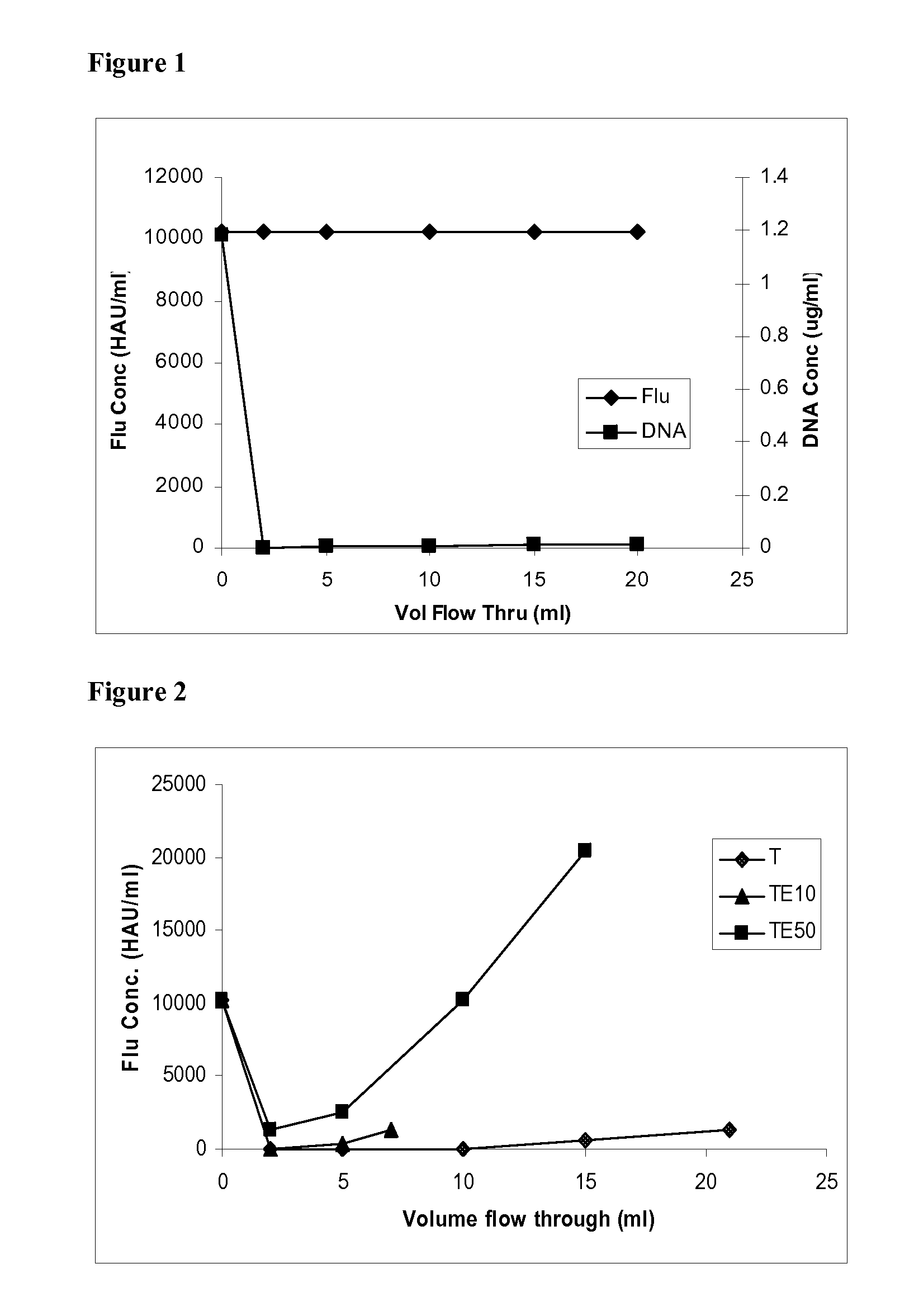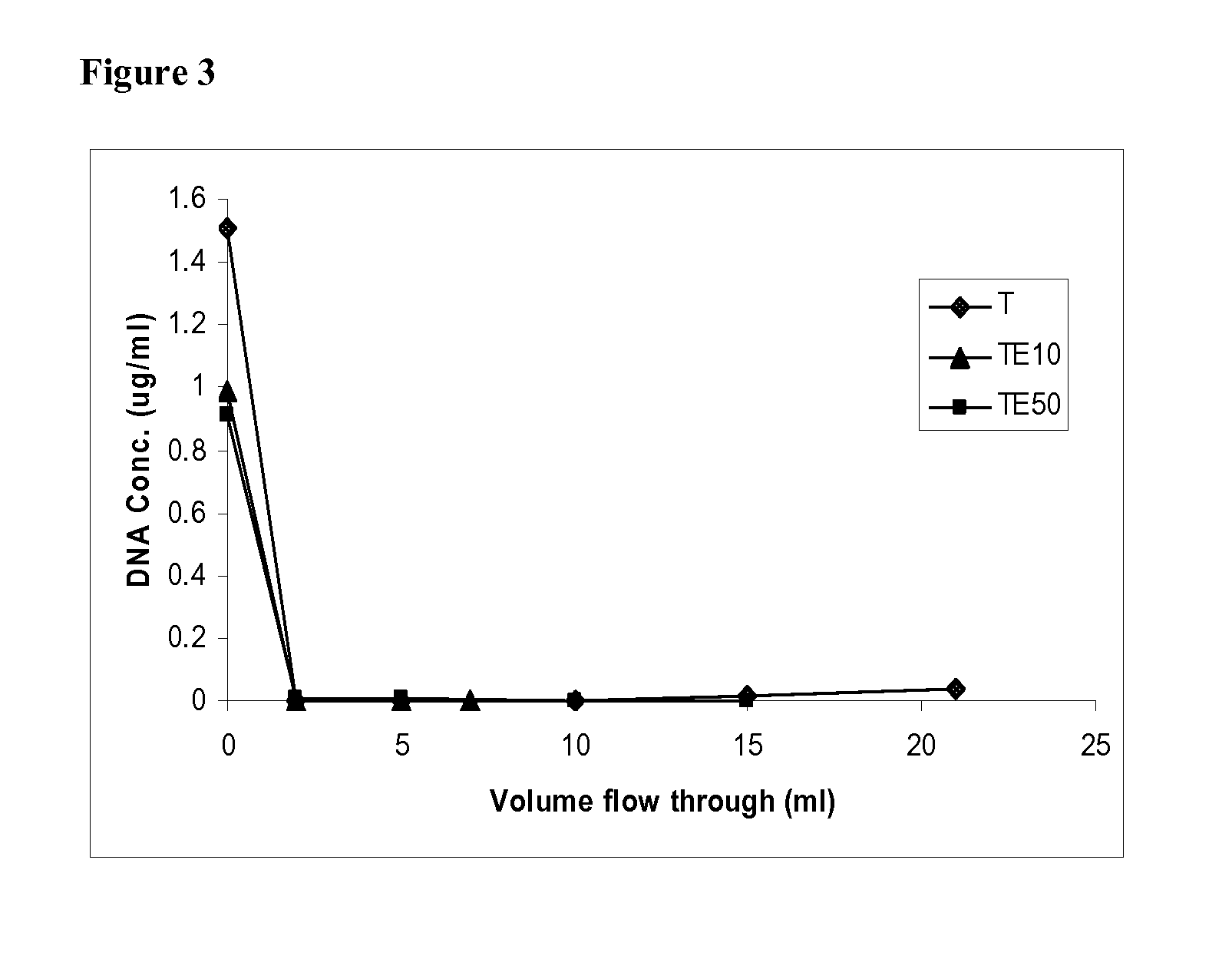Separation Of Virus And/Or Protein From Nucleic Acids By Primary Amines
a technology of primary amines and nucleic acids, which is applied in the direction of separation processes, recovery/purification, peptides, etc., can solve the problems of large volume columns, high adsorption capacity, and inability to impart acceptable adsorption properties, etc., and achieve significant and effective bonding capacity
- Summary
- Abstract
- Description
- Claims
- Application Information
AI Technical Summary
Benefits of technology
Problems solved by technology
Method used
Image
Examples
example 1
PAA on Hydrophobic UPE
[0051]Preparation of Polyamine Coated Membrane
[0052]A 20% aqueous solution of isopropyl alcohol containing 9% polyallylamine (PAA, Mw-15000 gm / mol), 0.4% PEGDGE (polyethylene glycol diglycidylether, Mw: 526 gm / mol), 4% lithium hydroxide, 2% TritonX-100, 8% of polyvinyl alcohol solution (2.5% solution) was first prepared. This was coated on a roll of hydrophobic UPE (ultrahigh density polyethylene) membrane with 0.65 μm pore size using a pilot scale coating machine. After coating, the membrane was extracted with water and methanol to remove excess reactants and dried on a hot air impingement dryer at 120° C. Following this, the membrane were subjected to curing at 95° C. for 15 hrs, treated with 5% sulfamic acid in 5% isopropyl alcohol and then dried to stabilize the coating. The membrane so prepared was cut into half inch or one inch discs, stacked into 8 layers, over-molded into polyethylene devices with an inlet and effluent port and further used for flow...
example 2
Flow Through Purification of BSA (Model for Virus) from DNA Using Chromasorb and Tris Buffer
[0053]In this exemplary experiment the flow-through recovery of bovine serum albumin (BSA) and herring sperm DNA using Tris buffer with different concentrations of sodium chloride salt as the mobile phase and a device built as described in Example 1 with the primary amine anion exchanger, is described. The membrane adsorber was built by over-molding 8 layers of membrane (1 inch in diameter, total membrane volume=−0.34 ml) from Example 1 into polyethylene devices with an inlet and effluent port. BSA was used as a model for proteins as well as viruses that need to be separated from DNA or other nucleotides in a sample. BSA serves as a good model for viruses too because it has a pI of −5 which is close to the pI of these biomolecules. Herring sperm DNA was used as a model for the host cell DNA and other similar nucleotides that would be found in a typical feed.
[0054]Prior to testing, the ChromaS...
example 3
Flow-Through Purification of BSA from DNA Using ChromaSorb Membrane and Phosphate Buffer.
[0058]In this exemplary experiment the flow-through recovery of bovine serum albumin (BSA) and herring sperm DNA using ChromaSorb device (a 0.08 ml single-use, membrane-based anion exchanger commercially available from Millipore Corporation) as the primary amine anion exchanger and buffer solutions containing multivalent phosphate ions and sodium chloride salt as the mobile phase is described. Similar to Example 2, BSA was used as a model for proteins / viruses and herring sperm DNA was used as a model for the host cell DNA.
[0059]Prior to testing, the ChromaSorb devices were wetted and degassed as per the method described in Example 2. The devices were then connected to an automated BioCad FPLC system (Applied Biosystems), and were flushed with 0.5N NaOH, washed with water and pre-equilibrated with sodium phosphate buffer (pH 7.1) with or without sodium chloride salt. The FPLC system was further...
PUM
| Property | Measurement | Unit |
|---|---|---|
| Volume | aaaaa | aaaaa |
| Volume | aaaaa | aaaaa |
| Volume | aaaaa | aaaaa |
Abstract
Description
Claims
Application Information
 Login to View More
Login to View More - R&D
- Intellectual Property
- Life Sciences
- Materials
- Tech Scout
- Unparalleled Data Quality
- Higher Quality Content
- 60% Fewer Hallucinations
Browse by: Latest US Patents, China's latest patents, Technical Efficacy Thesaurus, Application Domain, Technology Topic, Popular Technical Reports.
© 2025 PatSnap. All rights reserved.Legal|Privacy policy|Modern Slavery Act Transparency Statement|Sitemap|About US| Contact US: help@patsnap.com



